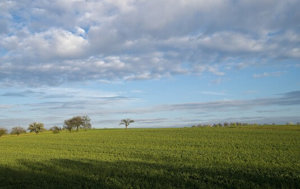Stay safe and get outdoors!

By Elizabeth Bassett
It looks like we may be socially distancing for a while to come. If the pandemic continues, we will all need to sort out how to stay safe, healthy and sane. For many Vermonters, playing in the outdoors may be the best solution for sanity. Why not take this moment to learn something new about the natural world that lies beyond the reach of our feet or a car trip?
Buy books from local bookstores that support our community with jobs, taxes, and community events. Bookstores are opening gradually, some by appointment. Buy a bird book, a tree or wildflower guide. On each walk, hike, or paddle, learn a new bird, tree, and flower. Naturally Curious by Mary Holland is a month-by-month guide with terrific photos through the fields, woods, and marshes of New England. Her essays and pictures on nest building, animal courtship, caterpillar metamorphosis, and pollination are informed and a delight to read.
Invasives removal. Kate Kelly at Lewis Creek Association orchestrates the removal of aquatic invasive species. Two volunteers in a canoe are socially distanced as they paddle our beautiful local waterways while helping to improve the health of our lake and its tributaries. To learn more or to volunteer, contact Kate Kelly.
Audubon links. While I am not encouraging more screen time, there are moments when it’s too hot, buggy, or rainy to be comfortable outside. Audubon Vermont has links to activities for children and adults at their website. These include virtual field trips; Skype a scientist (for free!); Ten Outrageous Ways Birds Dance to Impress Their Mates—Nature has way better moves than the Funky Chicken; and dozens of videos, webinars, and suggestions for outdoor activities.
Webinars. The Nature Conservancy—Vermont offers the Nature Uninterrupted webinar series, which is available on video if you miss the original online event. These include “Spring Wildflowers”; Virtual field trips: “Paddle the Flooded Forest through Otter Creek Swamps Natural Area” (recording available) and, on June 18, from 1:00 p.m. to 2:00 p.m., a visit to Eshqua Bog Natural Area to learn about its wild orchids, known as showy lady slippers, and the conditions that produce them; “Carbon Cents: A Natural Climate Solution,” an overview of the ability of trees to remove and store carbon and of emerging carbon markets that may help to protect Vermont’s forests (recording available).
Chittenden County Forester Ethan Tapper sends emails with links and information about upcoming webinars of interest like tree or wildflower identification. I’ve attended webinars about woody invasives (how to rid your land of buckthorn and other exotics), another on frogs, toads, and snakes, and one about northern white cedars, native trees that thrive along the shore of Lake Champlain. You will see nature with new, more informed eyes. Send him a note to get on this distribution list.
Keep a nature journal. For aspiring or curious writers, take this moment to record thoughts and observations about the outdoors. Sit quietly—probably protected by some bug repellent—and listen. Do you hear frogs, birds, owls, coyotes? Look around. Being still or walking slowly, especially if you usually move at a high speed, can reveal surprises. What excavated that huge hole in my pear tree? Pileated woodpecker, most likely. Who lives there now? A family of raccoons or owls? Unlike many avian creatures, owls do not build nests, making homes either in old crows’ nests or tree cavities.
I keep a nature journal that is organized by weeks (first week in June, for example). It’s nearly time for an enormous mother snapping turtle to lay her eggs in our driveway. For the past five years she has dodged Mt. Philo Road traffic, and she lumbers from her home pond to our driveway. Last year I was on the porch when I heard a scraping sound not far away. Mother turtle was digging a hole in the gravel with her rear claws. As darkness fell, she dug several holes (to distract predators) and finally selected one into which she deposited her eggs. She covered the eggs, again with her rear legs, before walking quite quickly, for a turtle, back toward her pond.
Open your eyes and mind to appreciate the wonders of our natural world!

